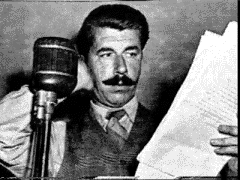
In 1936, newspapers were still regarded as the main source of news and information, and radio was primarily seen as a medium of entertainment. But on April 20th 1936 it was CBC’s Regional Director for the Maritimes, J. Frank Willis, who turned the ears of a nation to radio, with his fifty-six hour coverage of the desperate efforts being made to rescue three men trapped in the Moose River Mine in Nova Scotia.
The men – Herman Magill, Dr. David Robertson and Alfred Scadding – were on an inspection tour of the aging 55-year-old mine, to check its potential for sale. On April 12th, the roof collapsed, trapping the three men. It was six days before rescuers from nearby mines made contact with the trapped men, and began to dig through to where they were located. Sadly, Herman Magill died of pneumonia on April 19th.
On April 20th, J Frank Willis arrived at the pithead, with an engineer from CHNS Halifax, and began what was to be a marathon 56 hours of radio coverage, two minutes every half hour, as the rescuers fought to save the two remaining survivors, who were eventually brought to the surface late on the evening of April 23rd. It was estimated that 100 million listeners heard all or part of Willis’s dramatic coverage, some of which is heard here. The CRBC’s broadcasts were carried by the BBC and broadcast to Europe, and were carried on 650 stations in the U.S. including NBC affiliates.
